Sweetness, spice and melting – the perfect interplay of wine and food
Wine with food thrives on contrasts that combine to create harmony – which is exactly what this classic dish achieves. Tender, fried goose liver unfolds its velvety texture and subtle spiciness, while the apple and pear chutney forms an exciting counterpoint with its fruit, acidity and spice complexity. The freshly toasted brioche brings buttery sweetness into play and makes every bite perfect.
This dish embodies the great art of wine and food craftsmanship: salty meets sweet, creamy meets fruity, tender meets crispy. For all these elements to merge into one experience, it needs a wine that combines depth, balance and finesse – like a fine, mature sweet wine from the Bordelaise.
Ideal wine accompaniment: Sauternes (Bordeaux, France)
Sauternes from Bordeaux (France) is the undisputed classic with foie gras – and for good reason. This fine dessert wine made from botrytis-infested grapes (mostly Sémillon, Sauvignon Blanc and Muscadelle) has a beguiling aroma of honey, dried apricot, orange peel and candied peach, accompanied by subtle notes of vanilla, almonds and spices.
On the palate, the Sauternes combines sweet opulence with lively acidity and enormous length. This structure allows it to interact perfectly with the creamy foie gras: The sweetness envelops the savory melt, the acidity balances the fat, and the exotic fruit flavors reflect the chutney. The combination of brioche and wine also creates an almost caramel-like aftertaste. The result: a harmony in which wine and dish enhance each other – a perfect example of the interplay of maturity, elegance and sensory balance.
Further wine recommendations for this dish
Tokaji Aszú 5 Puttonyos (Tokaj, Hungary)
This legendary Hungarian sweet wine made from Furmint and Hárslevelű has intense aromas of honey, apricot, orange peel and cloves. Its natural acidity structure is remarkably lively and ensures that the wine remains fresh despite its sweetness. It shows its full class with foie gras: The fine botrytis spice and citrus notes emphasize the fruit of the chutney, while the texture harmoniously accompanies the melting of the liver. The Tokaji is somewhat firmer than Sauternes, which makes the interplay even more exciting and rich in contrast.
Beerenauslese (Burgenland, Austria)
Beerenauslese wines made from Welschriesling or Chardonnay have a finely balanced ratio of sweetness and acidity. They smell of acacia honey, yellow fruits and dried flowers, but show freshness and clarity on the palate. This combination allows the richness of the foie gras to be balanced without over-sugaring the dish. They are particularly harmonious when the chutney contains a subtle acidity from vinegar or lime – this creates a delicate dialog between fruit, fat and freshness.
Riesling Trockenbeerenauslese OmP (Mosel, Germany)
A Riesling TBA is pure liquid essence – honey, peach, candied citrus fruit, paired with electric acidity. This combination of sweetness and acidity is almost architecturally precise when paired with foie gras. The sweetness nestles against the melt, while the acidity lends structure and length. The mineral depth of a Mosel Riesling in particular makes the brioche and chutney appear even more complex. A wine for moments when perfection is required.
Vin de Constance (Klein Constantia, South Africa)
The legendary dessert wine from Muscat de Frontignan is full of exotic fruit, with hints of mango, candied orange, caramel and spice. It has an opulent sweetness, but also a refreshing tension. Its silky texture harmonizes beautifully with the foie gras, while its tropical fruit picks up and deepens the chutney. A perfect example that great sweet wines are not only at home in Europe – it offers intensity supported by finesse.
Late Harvest Chenin Blanc (Loire, France)
A late harvest Chenin Blanc from Vouvray or Coteaux du Layon shows golden fruit aromas, honey, lime blossom and a concise acidity. This keeps the wine lively and provides a playful balance between sweetness and freshness. In combination with the foie gras, a charming elegance is created: the wine emphasizes the melting, the chutney gains radiance and the brioche acts as a soft, buttery frame. A wine with character and subtle understatement.
The recipe:

Gebratene Gänseleber mit Apfel-Birnen-Chutney & Brioche
Cooking utensils
- 1 Pfanne
- 1 Topf
- 1 Schneidebrett & Messer
- 1 Kochlöffel
- 1 Toaster
Ingredients
Gänseleber
- 200 g frische Gänseleber
- 1 EL Butter
- Salz & Pfeffer
- Etwas Mehl zum Wenden
Apfel-Birnen-Chutney
- 1 Apfel säuerlich
- 1 Birne
- 1 kleine Schalotte
- 1 TL Honig
- 2 EL Weißweinessig
- 1 TL Butter
- 1 Prise Zimt
- Salz & Pfeffer
Brioche
- 2 Scheiben Brioche
- 1 TL Butter
Preparation
Vorbereitung
- Gänseleber parieren, trocken tupfen, leicht mehlieren.
- Apfel, Birne und Schalotte fein würfeln.
Chutney zubereiten
- Butter in einem kleinen Topf erhitzen, Schalotte glasig anschwitzen.
- Apfel und Birne zugeben, kurz karamellisieren, mit Honig und Essig ablöschen.
- Mit Zimt, Salz & Pfeffer abschmecken und 10 Minuten einkochen lassen.
Gänseleber braten
- In heißer Butter die Leber auf jeder Seite ca. 1–1½ Minuten goldbraun anbraten.
- Herausnehmen und kurz ruhen lassen.
Brioche rösten
- Brioche-Scheiben in Butter goldgelb rösten.
Anrichten
- Brioche mittig auf den Teller legen.
- Gänseleber daraufsetzen, Chutney daneben anrichten.
- Mit etwas Bratbutter oder Maldon-Salz vollenden.
Empfohlene Beilagen:
- Feldsalat mit Balsamico
- Feigenkompott
- Vanille-Zwiebelreduktion

